Time to look at one of my favorite colubrid species of all time! Come and find out why in my Mexican Black Kingsnake care sheet…
Last updated on June 23rd, 2023 at 04:48 pm
The Mexican Black Kingsnake (Lampropeltis getula nigrita) is a beautiful snake, which is why it is popular as a pet. This small species of snake is fairly easy to take care of: you just need to focus on providing it with the correct temperature, humidity, setup, diet, and hygiene.
Mexican Black Kingsnake full size
The size of the Mexican Black Kingsnake is around 3 to 5 feet. The average size of this snake is around 4 feet. There have been instances of some snakes growing up to 6 feet. But this is not very common.
When they are born, they are around 6 to 8 inches long. They grow very quickly and their size doubles every year.
The size of this constrictor snake allows it to eat small animals that are even larger than it.
Mexican Black Kingsnake natural habitat
The Mexican Black Kingsnake’s natural habitat ranges from Mexico to Arizona. The snake belongs to the genus of snakes that also has milk snakes and other popular kingsnakes like the California Kingsnake.
Just as the King Cobra eats other snakes, so does the Mexican Black Kingsnake. It eats other snakes and can even eat other Mexican Black kingsnakes.
There is an interesting fact about the name of the snake. Its scientific name is Lampropeltis, which means ‘shiny shield’. This refers to the shiny scales on the snake.
Thanks to its popularity as a pet, this snake is bred extensively. In the wild, it is found in Mexico, Arizona, the Sonoran Desert, and North-Western Sinaloa.
The snake has adapted to live in the desert, but also live in the shrub lands and grass lands. Since the snake’s natural habitat is hot, it remains hidden most of the time to protect itself against heat.
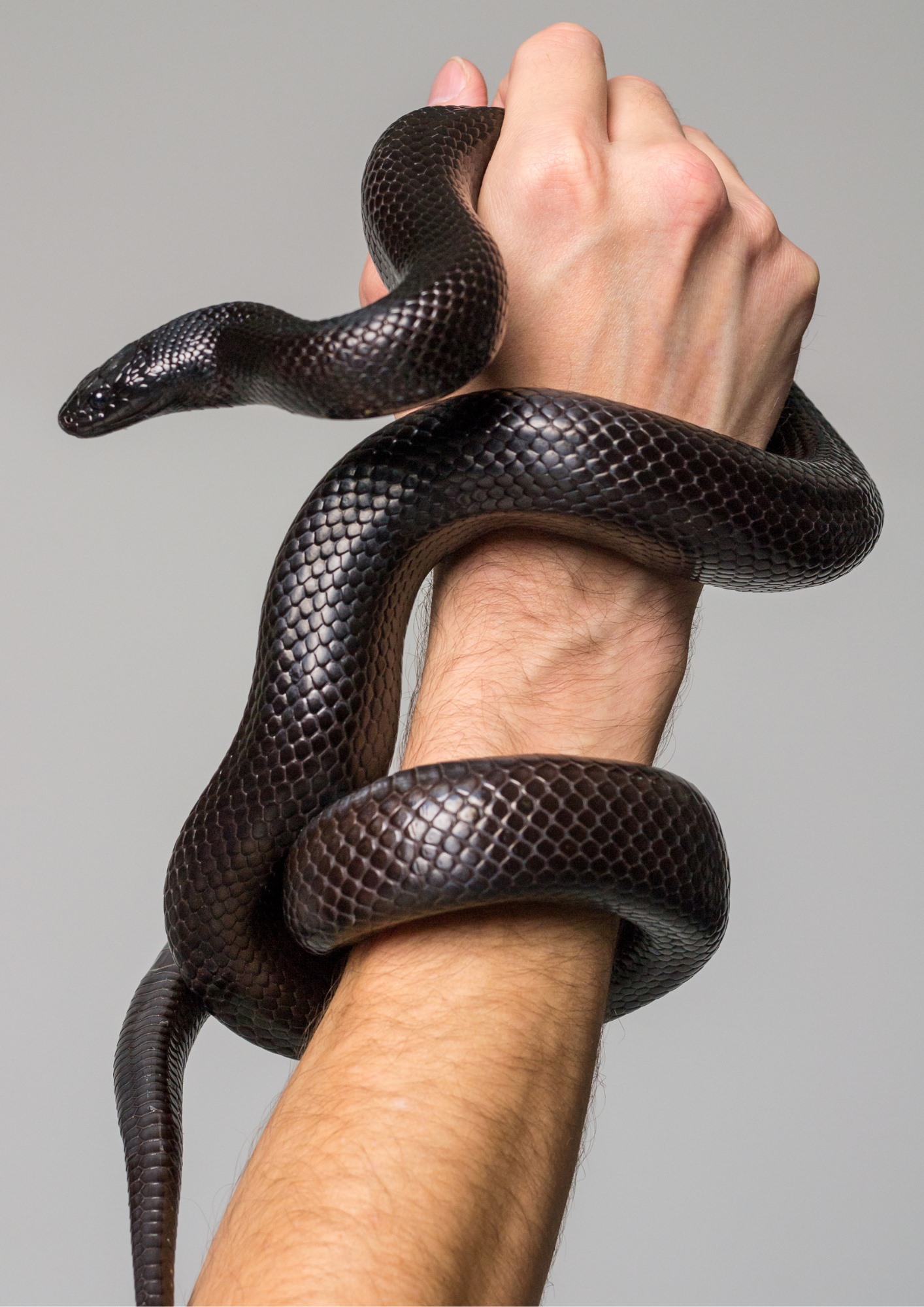
Temperature
Though they come from desert and semi-arid regions in Mexico, it’s important to remember that this subspecies is nocturnal, so it doesn’t come out into the blistering daytime heat.
In general, Mexican Black Kingsnakes do best with a thermal gradient of 85-90F on one side of their enclosure (the warm spot or “basking area”) to 75-80F on the cool side.
You achieve this by using a heat mat under one third of the enclosure, used in combination with a pulse-proportional thermostat. Alternatively, you can use a ceramic heat emitter mounted inside a proctective guard on the roof of the enclosure. Again, this kind of heating element is only safe if used with a pulse-proportional thermostat.
Heat bulbs aren’t a great source of warmth for nocturnal species, purely because you can’t leave them on at night with disturbing your snake’s activity rythm. You can use them, however, if you switch of the lamp at night and switch on a heat mat instead. This ofcourse requires two thermostats – one for each heating element.
If you do use a heat mat, it should be mounted underneath a glass tank or tub rather than inside. Whatever heating method you go for, the warm end (basking area) should cover around 30% of the floorspace. To figure this out, you can use my calculator below:
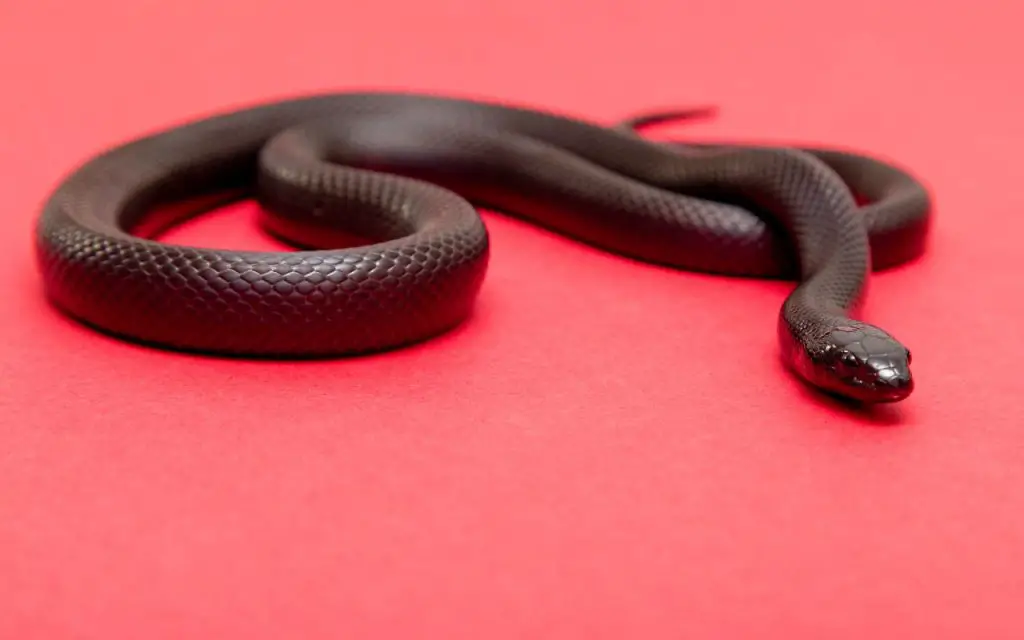
Lighting
Like every popular nocturnal snake species, more and more people are trying to convince us that Kingsnakes need UVB lighting. This really isn’t true. In fact, there are just as many studies that have found no detectable benefit from giving nocturnal reptiles UV light as there are that claim there is a benefit!
It would seem the only benefit is to people trying to sell more UV light bulbs to you. At this point you may notice that I don’t have any affiliate links on my site…
That said, all animals do need light of some kind. Even nocturnal animals need to know when it’s day vs night. So, make sure there is some light in the room you keep your Kingsnake in. It can be light from a window, or a light inside its enclosure – UV or other.
All I’m saying is that they don’t need UV light specifically because they are able to metabolise the vitamin D and calcium found in their food.
Humidity and Shedding
This snake does not need high humidity. The ideal humidity level this snake needs is from 40% to 50%. To maintain this humidity level, all you need to do is keep a large water bowl in the snake’s enclosure.
You can buy a humidity meter to keep track of the humidity. This is needed if you live in a place with low humidity. If you find the humidity getting very low, you can mist the enclosure to increase humidity.
Maintaining the proper humidity levels is important to ensure the snake sheds well. While humidity has to be maintained, care must be taken to ensure the surrounding do not become damp.
Dampness can cause diseases like scale rot and lung infections. So, monitor the enclosure to ensure
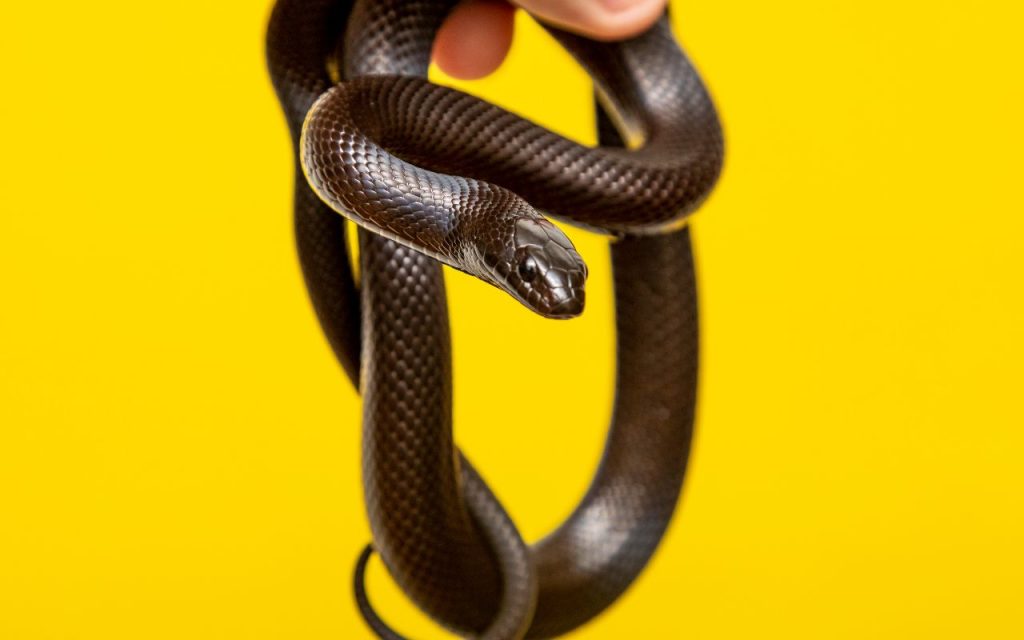
Water
Water is essential for the Mexican black kingsnake. It needs the water for drinking and would also soak in the water. You need to keep a large bowl of water in the enclosure. Ensure the bowl is heavy, so the snake does not tip over the bowl.
There must be sufficient water for the snake to drink. Your snake will love to soak in the water, so ensure the quantity is enough.
Every day you need to replace water and provide fresh water. In case, you see any fecal water in the bowl you should replace the water immediately.
At regular intervals, take out the bowl and clean it properly. Use soap and water to disinfect and to remove and buildup of slime.
Handling
The Mexican Black kingsnake makes for a good pet because of its docile temperament. However, this does not mean that the snake can be handled easily.
This snake is known to hunt its prey in the wild, so it has a tendency to attack. So, it takes time to handle the snake.
You need to start handling the snake slowly and gently from the time it is young. Over time, the snake will get adjusted to the handling.
This calls for patience, since the process of handling would be a bit difficult. Ideally, you should avoid handling the snake.
If you wish to handle it, then you need a lot of patience. Apart from striking out, the snake can musk or release a foul order if it is angry.
Tips for safe handling
If you would like to handle your Mexican Black kingsnake, then here are some tips that would help you:
- Never touch the snake’s head as it can cause a strong reaction. You may drop the snake in fear.
- The best way to start handling this snake is to use a snake hook. Pick the snake up gently using the hook.
- Using the hook ensures your safety, so the snake does not strike at you. Gradually, the snake will get adjusted to being picked up by the hook.
- You can then start handling it slowly. It will take some time for the snake to get adjusted to you.
- If you are comfortable using your hands to handle the snake, scoop it out gently.
- Ensure you hold one section of the snake, while supporting the other part.
- Allow the snake to gently move over your hands and body. Doing this for some time will help you bond with the snake.
- Don’t handle the snake when it is shedding.
- If the snake makes a rattling sound with its tail, don’t handle it. You can get bitten.
- Wash your hands clean before handling. If the snake smells other reptiles or prey it will attack you.

Mexican Black Kingsnake tank setup
The ideal tank for the Mexican Black kingsnake is one made from glass. A young snake will need at least a 10 gallon tank. As the snake grows, you need to increase the tank size.
20 to 30 gallon size tank should be sufficient. If your Mexican black kingsnake grows to full size, then you can get a 40 gallon tank.
A bigger tank is always preferable, since this snake is active and would keep moving around. Ensure the tank is securely closed with a lid or door because the snake is capable of escaping.
Avoid enclosures made of wood as they can develop mold. Keep perches, branches, and rocks in the enclosure. This will allow the snake to move around the tank and explore its home.
Never keep more than one snake in a tank. This species of snake is known for its cannibalistic nature and can kill and eat the other snake.
Substrate
The natural habitat of this snake is dry. Hence, you don’t need to use mulch or any substrate that enhances the humidity.
You can use newspapers or paper towels with aspen shavings as the substrate. Avoid cedar or pine wood shavings, since they can be toxic to the snake.
You can also add some dry leaves to the substrate to simulate the snake’s natural environment. Avoid adding very small shavings that the snake may eat.
Diet
In the wild, this snake eats rats, lizards, and other snakes. When kept as a pet, you can feed it mice or chicks.
Ideally, you should feed the snake frozen mice or rat chubbs. You can buy the food from a pet shop and keep it in the freezer. Avoid giving live prey, since its teeth can harm your pet.
Before feeding, take out the mice from the freezer and put it in a tub of warm water to thaw.
While feeding using prongs to introduce the mice into the enclosure. Never use your hand since the snake can bite your fingers as it would smell of the mice.
Sometimes, your snake may refuse to eat the mice. Wait for a couple of hours and use the prongs to take away the mice. Throw the refused mice away and don’t put it back in the freezer as it can spoil and affect your snake’s health.
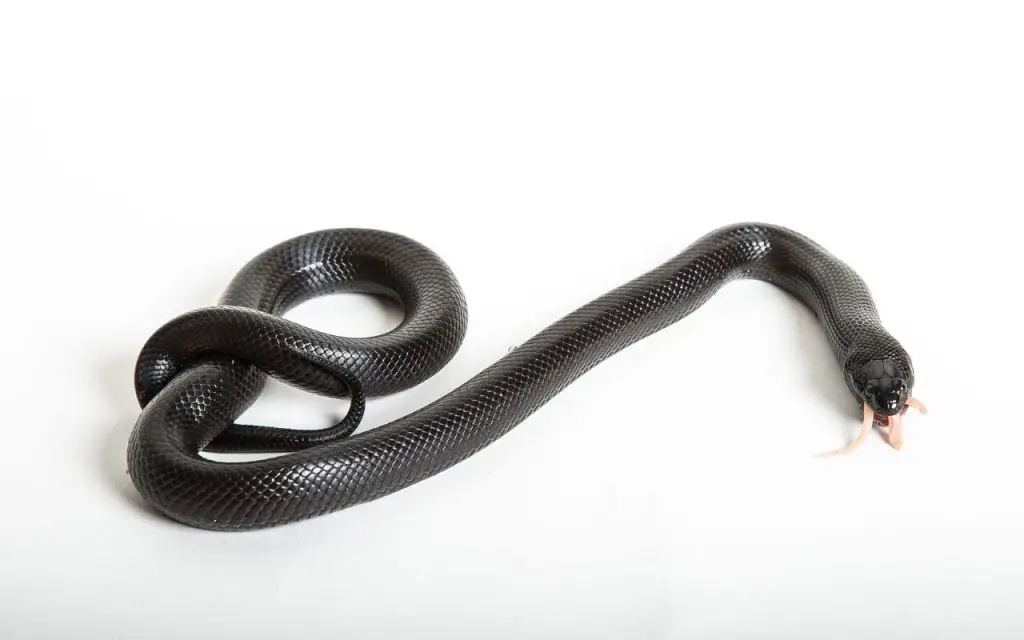
Mexican Black Kingsnake feeding chart
The following can be kept in mind while feeding the Mexican Black kingsnake:
- While this snake can eat prey larger than itself, avoid giving it very large prey. The size of the prey should not be more than the snake’s size at the largest section.
- Apart from mice, you can also offer chicks or quail eggs, though not all Kingsnakes will take them
- Hatchlings have a good appetite and you can feed them once in every 5 or 7 days.
- Adult snakes can be fed once in a week or 10 days.
- Don’t feed the snake when it shedding. Wait until the shedding is complete before resuming feeding.
| Age: | Feeding interval: | Prey size: |
| Hatchling/juvenile | every 5 to 7 days | pink mouse or fuzzy mouse |
| Subadult | every 7 days | small or medium mouse |
| Adult over 24 months | every 7 to 10 days | one or two large mice |
Hygiene
It is important to maintain proper hygiene in the enclosure. Not doing so exposed your snake to the risk of infection and diseases.
Remove any uneaten food from the enclosure. Change water daily and clean the water bowl. If the tank has become dirty, you need to clean it. Proper hygiene allows your pet snake to flourish and be free from diseases.
It is recommended to buy a veterinary disinfectant such as F10, or a disinfectant made specifically for reptiles such as those sold by major companies like Fluker or Zoo Med. You can easily find any of these on eBay or Amazon.
Price and availability
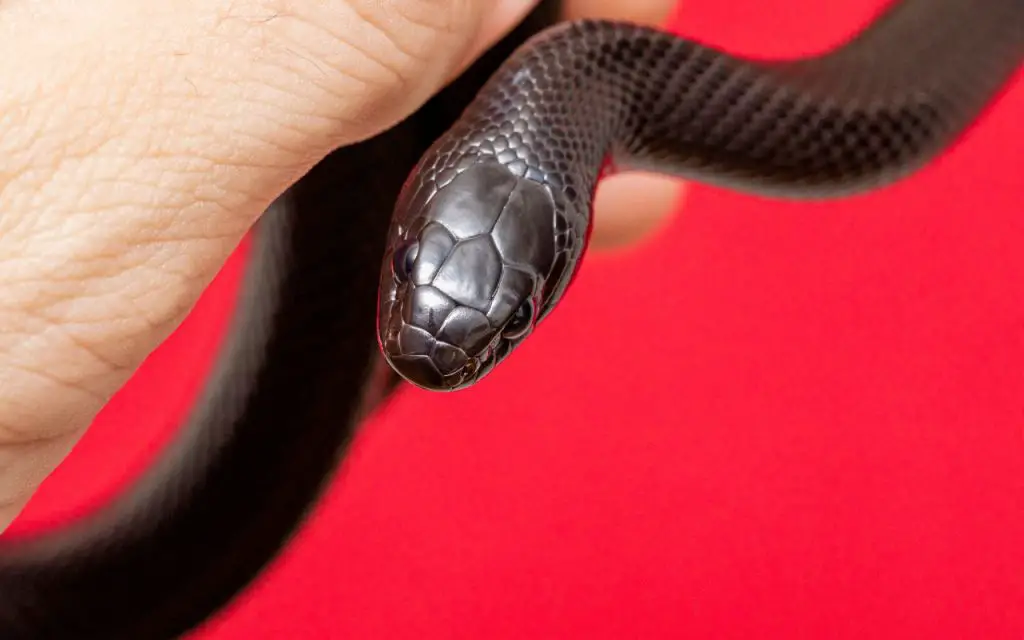
If you are looking to keep a Mexican black kingsnake as a pet, ensure you buy from trusted sources.
You can buy online through well-known reptile and pet marketplaces. You can also buy from a reptile store. Just make sure that whoever you buy from has a good reputation. Check the ratings on their social media page and any other sites they are a member of.
Since the snake is in demand, its average price (for a hatchling) is $150-250. Occasionally, you can get hatchlings for as little as $120, so it’s worth going on websites like Morphmarket.com and having a shop around.
Mexican Black Kingsnake care summary
| Temperature: | 85-90F (29-32C) on the warm end and 75-80F (24-27C) on the cool end |
| Humidity: | 40 to 50% |
| Favourite food: | Rat chubbs or mice |
| Enclosure size: | 12inches (30cm) long tub or 10 gallon tank for juveniles, 36inches (90cm) long tub or 30 to 40 gallon tank for adults |
| Activity rythm: | Nocturnal |
| Lighting needs: | UV light not necessary, but ambient lighting in the room beneficial |
FAQ related to Mexican Black Kingsnake care
Are Mexican black kingsnakes hard to take care of?
Mexican Black Kingsnakes are not hard at all to take care of. In fact, they are a hardy species that can live for a long time in a simple setup. You just need to pay particular attention to their humidity, and keep it to 40% to 50%. Too humid, and they will get sick.
Do Mexican black kingsnakes need heat lamps?
Mexican Black Kingsnakes do not need heat lamps. They do just fine with a heat mat, radiant heat panel, or ceramic heat emitter. The important thing is to always use any heating element with an appropriate thermostat to prevent burns or overheating. For heat mats or ceramic heat emitters, pulse-proportional thermostats should be used.
How often should you feed a Mexican black kingsnake?
You should feed your Kingsnake less often as it gets older and its metabolism slows. Start out feeding hatchlings every 5 to 7 days, then reduce it to every 7 to 10 days by the age of 24 months.

